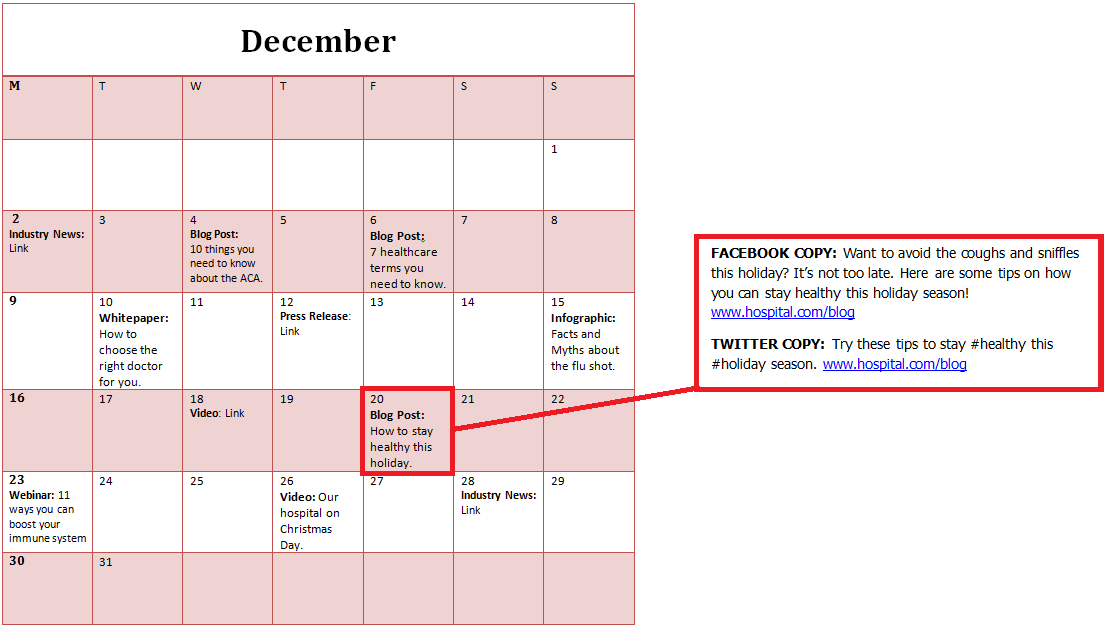Why is “content” such a big buzzword nowadays? Because content is key to attracting and converting prospects and nurturing consumer relationships. And because healthcare ranks among the most popular consumer content, hospitals should leverage their vast expertise to become an information hub for all things healthcare.
An effective content marketing strategy puts your hospital in the minds of consumers before they need your expertise, and lingers well after your patients have recovered. Which means you won’t just be a place people go to for care, but you also become a trusted resource for patients and visitors who are seeking additional resources for their health. This is a powerful position to be in, especially in an age of increasing consumer choice.

By repurposing and extending your content through various vehicles, you’ll maximize your SEO for optimal brand exposure. 86 percent of individuals search for health-related information online. So if your hospital isn’t already creating content, it’s time to include it in your hospital marketing strategy. It will drive traffic to your hospital website and generate leads for prospective patients. And although it may cost you some extra time and investment, this strategy is extremely budget-friendly.
Take these five steps to create content that will optimize your hospital brand exposure:
1. Assemble a content team – That’s right. It takes a team to create effective content. So don’t leave the job to one person. Because it’s more than just writing a few paragraphs here and there. It’s an opportunity for your hospital to demonstrate expertise and increase demands for your services. That’s because 61 percent of people feel better about a company that delivers custom content and are more likely to buy products or get services from that company.
Whether you’re developing content for your website, blog or social media, it’s important to designate point people who will commit to creating and sharing new, relevant information. Your content team should consist of at least:
a. A team lead who will oversee and manage all content deadlines, track progress, provide feedback, generate content ideas and ensure goal execution.
b. A strategist who will oversee the objectives, create and ensure effective strategies, edit content and advise topics based on news and changes in healthcare.
c. Writers who will provide idea feedback, contribute ideas in brainstorms, research and develop content to share.
When you assemble a team devoted to creating content, you are ensuring that this task won’t be pushed to the back burner. So not only are you one step closer to making your hospital a leader and distributor of healthcare information, you’ve also taken a big leap ahead in the SEO competition.
2. Know your audience – It’s no surprise that 74 percent of online consumers are frustrated with websites when content has nothing to do with their interests. So before your team begins creating content, it’s important to understand who your audience is. Obviously, current and potential patients are key. But what about other audiences you’re trying to attract, perhaps doctors, other healthcare providers, employees? Knowing where your content will live and who will potentially read it is crucial for developing effective content. And you certainly don’t want to invest time creating content that no one will even read. Tap into your website analytics program to see who your visitors are so you can better understand their demographic, what brings them to your website and what they’re searching for once they’re there.
3. Create a blog – Did you know companies that blogs get 55 percent more web traffic? A blog is the perfect way to host your content, increase your search engine optimization (SEO) and ultimately promote your hospital, physicians and expertise. So if your hospital doesn’t currently have a blog, it’s time to create one. Blogging is the first step to an effective inbound marketing strategy, attracting new people to your website and turning visitors into patients. And the best thing about a blog? It doesn’t cost your hospital anything. Unless you’re putting dollars behind your content for promotion, there are no major expenses to hosting and managing a blog – a perfect solution for your limited budget.
4. Provide downloadable materials – Your hospital is a leader in healthcare information. So it’s important to share that knowledge with the community as well as other experts in your industry. Whether it’s leading edge research, insights into the healthcare industry or health tips and information, create content that people can download in PDF form, like a whitepaper or eBook. Market this content on your website so visitors can easily find the information they’re looking for.
For example, you can find this download button on our Brogan homepage:

5. Make a content calendar – You have your content team. You know your target audience. You started a blog. What next? It’s finally time to start creating and sharing content. Creating a content calendar is a great way to organize what information you’ll be sharing for the month. It can also help you plan ahead and brainstorm potential content you can share around the holidays, special events and more.
The more content you share, the more traffic you’ll get. This can include (but is not limited to):
- Blog posts
- Case studies
- Company news
- eBooks
- FAQs
- Industry news articles
- Infographics
- Newsletters
- Press releases
- Relevant research
- Videos
- Webinars
- Whitepapers
Aim to publish and share content 2-3 times a week on your social media channels. It’s the perfect way to get people to see your content and share it with others. Here is an example of what your content calendar (and its corresponding social media posts) could look like:

Most importantly, don’t be overwhelmed. Your job is to repurpose content, not recreate it. There’s already a lot of information out there, so your main objective is to find out how you can best repurpose the content and share it with your audience.
Find more suggestions on how you can overcome hospital budget cuts.























